BIRDING ROUTES IN PERU
Peaks To Parrots
Birding Route in Southern Peru
Best April-October; 1000+ species occur, but lower concentrations of endemic and threatened species than some other routes.
One of the great altitudinal transects in tropical America, southeastern Peru offers a rich birding experience to first-time and experienced birders in South America. Combined with a visit to the world-famous archeological ruins of Machu Picchu, the ancient charms of the city of Cusco, and the world-class Peruvian cuisine, this area has become a popular birding destination.
The Peaks to Parrot Birding Route is the best of birding in southern Peru. From exploring the Polylepis forests that often exceed 4,000 meters to see the Royal Cinclodes to the Amazonian lowlands to watch flocks of Blue-headed Macaws congregate at salt licks, this itinerary has it all. Get acclimated, then explore!
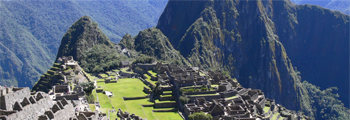
Sacred Peaks of Vilcanota: Situated near Cusco the Sacred Valley is the gateway to Machu Picchu and has spectacular archeological ruins of its own, such as the fortress at Ollantaytambo. Snow-capped peaks and glaciers hang above the northern side of this valley, beckoning to trekkers, mountain-bikers, birders, and other adventurers to explore. Peruvian conservation organization, ECOAN, with support from ABC, has helped seven communities within the valley to establish government-recognized Private Conservation Areas (PCAs) on their lands, and more are in process. ECOAN has also helped the communities establish trails, signs, and a visitor center where tourists can sign in and pay a modest entrance fee to the community.
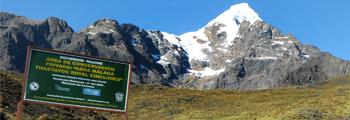
The best way to arrange your visit is through ECOAN (email reservas@ecoanperu.org), They can help arrange transportation, guides, packages and other logistics and ensure the communities know you are coming. Highlights include:
Abra Málaga is the most popular Polylepis forest for birders to visit as the forest is a relatively short walk from a paved highway that crosses the Málaga Pass towards the eastern slope of the Andes. These forests grow at higher elevations than any in the world, with many patches exceeding 4,000 meters above sea level, and harbor a suite of endemic and endangered birds. Sought after-birds found here include: Andean Condor, Royal Cinclodes, White-browed Tit-Spinetail, Tawny Tit-Spinetail, Ash-breasted Tit-Tyrant, Giant Conebill, and many others.
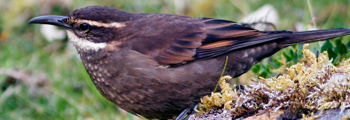
Be sure to look at the local textiles woven by women in the community at the visitor center for sale. Those willing to hike farther and overnight can access larger Polylepis forests and other PCAs managed by communities in the Sacred Peaks of the Vilcanota Mountains.
Trekkers can combine Abra Málaga with Choquechaca PCA for a 2-day route. Choquechaca PCA can also be reached during a day-hike about 2-hours walking uphill from the nearest road in Huilloc, which itself is a short drive from Ollantaytambo.
Lares Route – Sacred Peaks Spectacular: This trekking route takes 2-4 days to complete, passing through the communities of Lares, Huacahuassi, Pampacorral, Cuncani, Patacancha, and ends in Ollantaytambo. It passes through a Polylepis patch near Cancha Cancha, which is one of the best places for Royal Cinclodes. Cancha Cancha is also accessible via a 4+ hour hike from the nearest road. Quishuarani PCA is along this route and also accessible by trail and by road. A patch of Polylepis forest is located uphill of the village, which could also be done as a long day trip from the Sacred Valley. Check out the community tree nursery here as well. Pampacorral is accessible by road, and established a PCA that includes recently planted Polylepis, a large wetland, and stands of the century plant Puya raimondii. Mantanay PCA along this route protects one of the largest Polylepis forests in the Sacred Peaks. Visiting involves hiking uphill and camping, but also affords spectacular views of glaciers and a mountain lake.
Patacancha Basin Route: This two-day trek passes through the communities of Pallata, Huilloc, Patacancha and Rumira Sondormayo, and community PCAs.
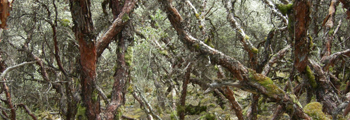
Machu Picchu: South America’s most famous archeological ruins can be visited as a day trip out of Ollantaytambo, or as a more extensive trekking tour on the Inca Trail. There are many operators offering tours at varying price points, but all visitors must be accompanied by government licensed guides into this World Heritage Site. There are too many operators to list here, but we recommend making your reservations in advance of your arrival. Also, many of the other operators listed in this Peaks to Parrots Route can help you make arrangements to visit this site. Aside from mystical ruins and megaliths, and even more spectacular landscapes, there are many great birds which can be seen here including the endemic Green-and-white Hummingbird and Inca Wren. The train ride into Aguas Verdes is great for seeing Torrent Duck along the river that parallels the tracks. Hummingbird feeders on the grounds of the Machu Picchu Pueblo Hotel are worth a stop.
Manu Road: A narrow road passes over the Andes from Cusco and winds its way down towards the Amazonian lowlands ending at the Alto Madre de Dios River. On the way out of Cusco, stop by Huarcapay Lake for waterbirds and the Bearded Mountaineer. This road passes though the buffer zone of the Manu Biosphere Reserve, descending from puna grasslands above treeline to steaming jungles below. More than 1,000 species of birds have been observed along this transect and in the Manu Biosphere Reserve, making it a premier global birding destination.
Upper Cloud Forest:
Wayqecha is a research station operated by a conservation group called Asociación para la Conservación de la Cuenca Amazónica (ACCA), located in the upper-most cloud forests of Manu road. The station is also frequented by birders. It offers double rooms to tourists at USD $100/night/person which includes all meals and private bathrooms. Wayqecha can accommodate up to 12 tourists at a time.
Reservations can be made through ACCA by emailing reservas@conservacionamazonica.org, which can also help visitors arrange transportations and longer tours, including extensions to Machu Picchu as a 2-day side trip, tours tailored to hard-core birders or blended tours where people learn about ACCA’s conservation work, visit indigenous communities and watch birds and other wildlife. More information on Wayqecha can be found at ACCA’s fact sheet.
The Mid-elevation Cloud Forest around 2,000 m elevation in the San Pedro area of the Manu Road is serviced by several lodges including Cock-of-the Rock Lodge, Manu Cloud Forest Lodge, and others. The highlight here is a lekking area for Andean Cock-of-the-Rock, but mixed flocks of tanagers, hummingbird feeders, and hundreds of other species can be seen too. See the Valqui guide recommended below for more information on lodges in this area.
The Foothills & Ridges at the bottom of the Manu Road offer many of the first lowland species as well as rarities of outlying ridges. Bird diversity appears to peak here where Andean and Amazonian avifauanas overlap producing some of the highest site lists of anywhere on Earth. Several lodges offer ample birding opportunity in this zone:
Villa Carmen Biological Station is another hotel and research station operated by ACCA located near the bottom of the Manu Road, just 1.5 km from Pillcopata. It offers double rooms to tourists at USD $89/night/person which includes all meals and private bathrooms. Reservations can be made through ACCA (see email contact above), which can also help visitors arrange transportations and longer tour packages. Villa Carmen can accommodate up to 12 tourists at a time. More information on Villa Carmen can be found on their factsheet. ABC contributed to ACCA’s acquisition of this 7,574 acre property in 2010.
Amazonia Lodge is the oldest lodge in this area, and located just on the other side of the Pini Pini ridge adjacent to Villa Carmen. Its bird list tops 600 species, and offers an extensive trail system, canopy and marsh tower, and hummingbird garden. Highlights include Blue-headed Macaw, Wattled Guan and bamboo specialists. It is run by the Yabar family. Both sons are birding guides and ABC has hired Ramiro Yabar (the elder son) as a bird guide for tours in northern Peru. Details on reservations, tours, bird lists and more can be found at Amazonia Lodge’s website.
Pantiacolla Lodge is located further down the Alto Madre de Dios River. Similar species as at Villa Carmen and Amazonia Lodge may be found here, as well as some harder ridge specialties like Sharpbill. More details can be found at their website.
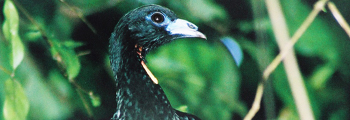
Amazonian Lowlands below 500 m: There are multiple lodges along the Manu River upstream of its confluence with the Alto Madre de Dios. Additionally, there are many lodges accessible from Puerto Maldonado, a jungle city serviced by commercial jets from Cusco. Clay licks visited by flocks of macaws can be seen on both the Manu and Tambopata rivers, with the most famous and studied at Tambopata Research Center. There are many options, but we list one site below in particular that is a bit off the trodden path for consideration.
Los Amigos Biological Station (CICRA) is one of the premier research centers in the Amazon basin, offering extensive trails through a variety of habitats including upland terra firme and floodplain forests, early successional habitats along rivers, oxbow lakes, Mauritia palm swamps, and numerous stands of Guadua bamboo. Tourists can stay in private cabins with private bathrooms for $100/night/person or in a dorm with shared bathrooms for $55/person/night. These prices include delicious and traditional Peruvian meals prepared on site. Operated by ACCA, please make arrangements and reservations by contacting reservas@conservacionamazonica.org
Frontier birding the road to Iberia: Road improvements have improved access (and accelerated deforestation) from Puerto Maldonado north to the Brazilian border. This area of Peru is just beginning to be explored, but offers more intrepid birders opportunities to see recently described species such as the Rufous Twistwing and Acre Tody-Tyrant in Guadua bamboo forests. Basic hotels in small towns along the way offer places to stay from which to explore.
Guides and Travel Agencies: Many international and Peruvian tour agencies offer birding trips in this part of Peru, including VENT, Wings, Field Guides, Rockjumper, Manu Expeditions, Rainforest Expeditions, among many others and private tour guides.
Books: There are many travel books that visitors to this area may find useful, particularly for finding restaurants, hotels, and transportation options. The following books and audio CDs might be of particular interest to bird-watchers. The Valqui (2004) bird-finding book can be hard to find but has detailed information of birding sites along this route and the Schulenberg et al. 2010 field guide is simply a must for birders to make sense of this hyper-diverse avifauna. The audio-CDs below are also useful for learning bird vocalizations in this area as many species are easier to hear than see.
Valqui, T. 2004. Where to watch birds in Peru. Lima: Grafica Nañez S.A.
Schulenberg, T. S., D. F. Stotz, D. F. Lane, J. P. O’Neill, & T. A Parker III. 2010. Birds of Peru: Revised and Updated Edition. Princeton University Press, Princeton, NJ, USA.
Schulenberg, T. S. 2000. Voices of Amazonian birds, Vol. 1: tinamous through barbets. Cornell Laboratory of Ornithology, Ithaca, NY, USA.
Schulenberg, T. S. 2000. Voices of Amazonian birds, Vol. 2: toucans through antbirds. Cornell Laboratory of Ornithology, Ithaca, NY, USA.
Schulenberg, T. S. 2000. Voices of Amazonian birds, Vol. 3: ground antbirds through jays. Cornell Laboratory of Ornithology, Ithaca, NY, USA.
Schulenberg, T. S. 2000. Voices of Andean birds, Vol. 1: birds of the hill forest of southern Peru and Bolivia. Cornell Laboratory of Ornithology, Ithaca, NY, USA.
Schulenberg, T. S. 2000. Voices of Andean birds, Vol. 1: birds of the cloud forest of southern Peru and Bolivia. Cornell Laboratory of Ornithology, Ithaca, NY, USA.
Links:
eBird Perú
BirdingPal
Jacamar Bird Club
Southern Peru birding map by Promperú
Contact us for more info
|